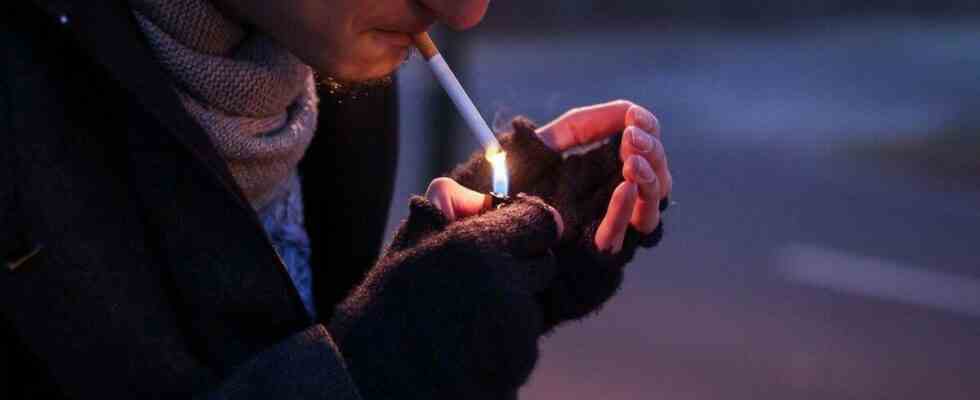“Your report is adopted by 97% of the votes… Which would make many candidates green with envy at the moment”, greets Patrice Tran Ba Huy, president of theNational Academy of Medicine in front of an audience of proud and concentrated high school students.
This Thursday, it was not the seasoned doctors of the Academy who shared their recommendations, but students of 1st of the Charles de Foucault high school, in the 18th arrondissement of Paris. The latter have developed several ways to improve prevention of risky behavior among young people.
“84% of young people questioned are not satisfied with prevention actions”
At the desk, Silina, Joshua and Yanï present the work of their entire class on sensitive subjects at this age: the use of tobacco, alcohol, cannabis and hard drugs, but also unprotected sex. The class, supported by its teacher, Raphaël Rodriguez, established a questionnaire with 500 young people aged 15 to 23, in order to give some quantified feedback. “About 47% of people 19 and older smoke, 50% have unprotected sex,” Silina lists. And his comrade Joshua added: “Young people are actors in multiple risky behaviors, and prevention campaigns have proven to be in great demand. One thing is certain: they do not work. In fact, 84% of young people questioned are not satisfied with prevention actions. »
Hence four ways to better reach young people: as a priority, campaign on social networks, in particular by giving a voice to influencers. Then, promote actions within schools. Then highlight existing sites on the Internet. And lastly, launch campaigns on television, further proof that young people are turning away from this media… Michel Lejoyeuxaddictologist and academician.
“Social networks, a major communication tool”
There follows a series of questions and answers in which the high school students indulge. Because the question remains unanswered: how to better sensitize very different adolescents? “A classmate told me that her perception of risk had changed thanks to Solidayswhich shows that entertaining actions can change the look,” Joshua breathes.
“I followed a lot of prevention actions in college from adults, adds Silina. But I think there was too great a distance, a 5th grade student will be little affected by the damage of tobacco on a fifty-year-old. I think that asking high school students, young and cool, to intervene in college, it would avoid hierarchy, create a link and make a greater mark on people’s minds. I also think that social networks are a major communication tool, we should take advantage of them rather than pointing fingers at them. »
The three high school students find their places under the applause of the comrades and the doctors, amazed by so much maturity. “I didn’t panic, I didn’t cry! Silina exclaims when she finds her friends. “You will sign the autographs afterwards”, takes them up with humor the president of the session, before inviting Jean-Pierre Goulle, professor of toxicology and pharmacist-biologist, to present his presentation on “Alcohol and drugs, what you need to know”. Something to recall high statistics: in France, 6 out of 10 terminal students have already smoked tobacco, 4 out of 10 cannabis, and half indulge in binge drinking. With a small note of hope: the figures have been falling for a few years for these three drugs.
Effective programs and essential training
Finally, Nicolas Prisse, president of the Interministerial mission to combat drugs and addictive behavior (Mildeca). “Let’s keep in mind that representations and economic interests are at the heart of these questions of addiction,” he reminds us. Mildeca has conducted studies to see which preventive actions bear fruit. “What seems to be working best, and which is partly driving the improvement in the numbers, are programs that are implemented from the end of primary school to secondary school to develop psycho-social skills. To develop a better self-image, critical thinking. We see that eight months after the program, there is a 50% reduction in the use of tobacco and alcohol. The Ministers of Health and Education are also in the process of developing a deployment strategy for these twelve-session programs with trained teachers. »
Training that is essential. “Peer prevention works. In the universities the health relay students, trained, get good results. But some peer actions are counterproductive. So beware of the pitfall that would conclude that everyone can do prevention! »
It is not Tasnim, 17, who will say the opposite. “I attended two completely opposite prevention actions, she confides during the lunch break. The first, in 5th grade, on risky behavior on the Internet, with a Powerpoint and no interactivity. I learned a lot… but nothing retained! The second, in 4th, it was the opposite. A man was talking emotionally about drugs. Since he was from my neighborhood, I could visualize the bars. But it lacked information. I also learned a lot this morning… And I realize that we often have a closed view of risky behavior. My friends look like me, smokers stick to each other… Now I know the statistics and I understand the problem better. »

